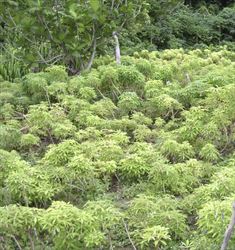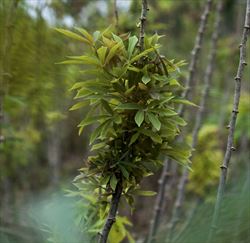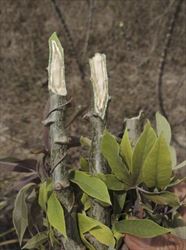- Widespread. In Oceania only from Wallis and Futuna. Mostly, confined to cassava; some weeds are hosts.
- Diseases cause yellowing of leaves, bunching of shoots - growth of normally dormant buds - sometimes vascular tissue discolouration, occasionally leaf mosaics, rough skin, cracking, woodiness of storage roots. Yield and starch losses impact farmers and processors. Examples include:
- Cassava frogskin (South America). Symptoms mainly on storage roots: thin, woody, deep cracks, sometimes forming rings around roots.
- X-disease (Brazil). Yellow, distorted leaves; stunting; witches’ broom symptoms.
- Witches’ broom (Thailand, Vietnam). Symptoms of witches’ broom; browning of vascular tissues; poor storage root development.
- Unnamed (Uganda). Yellowish leaves; slight stunting.
- Unnamed (Cote d’Ivoire). Yellowing of leaves and mosaic patterns. Similar phytoplasma to St Paul Wilt Disease of coconut.
- Unnamed (Wallis and Futuna). Yellowing and bunching of shoots.
- Spread: cuttings for propagation; possibly, phloem-feeding insects (leafhoppers and planthoppers).
- Biosecurity: risk from unofficial introduction of diseased cuttings for propagation. Official movement of germplasm should follow the FAO/IPBGR Technical Guidelines.
- Biocontrol: none.
- Cultural control: take cuttings from apparently healthy plants; rogue plants with symptoms; avoid planting next to cassava with disease.
- Chemical control: not a method to use, as little known about spread by insects.
Pacific Pests, Pathogens and Weeds - Online edition
Pacific Pests, Pathogens, Weeds & Pesticides
Cassava phytoplasma diseases (521)
Cassava phytoplasma diseases.
Classified as Candidatus Phytoplasma, with the species determined by tests of the 16S ribosomal RNA gene. The phytoplasmas of cassava fall into several groups, e.g., Candidatus Phytoplasma asteris, 16SrI; Candidatus Phytoplasma aurantifolia, 16SrII, and others. This way of naming them will remain until they can be cultured and tests prove they are the cause of the diseases associated with them.
AUTHOR Grahame Jackson
Information from Cassava witches' broom disease. Pest management decision guide: green list. Plantwise. CAB International. (https://www.google.com/search?q=cassava+witches%27+broom+disease&oq=cassava+witches%27+broom+disease&aqs=chrome..69i57j0i22i30.16960j0j7&sourceid=chrome&ie=UTF-8); Alvarez E, et al. (2013) Detection and identification of ‘Candidatus Phytoplasma asteris’-related phytoplasmas associated with a witches’ broom disease of cassava in Vietnam. Phytopathogenic Mollicutes 3(2): 77-81; and Kta KD, et al. (2017) First report of a phytoplasma affecting cassava orchards in Cote d'Ivoire. New Disease Reports 35: 21. (https://www.ndrs.org.uk/article.php?id=35021#); and Arocha Y, et al. (2009) Occurrence of 'Candidatus Phytoplasma aurantifolia' (16SrII group) in cassava and other species in Uganda. Plant Pathology; and from Álvarez E (2019) Phytoplasma Diseases Affecting Cassava. In: Olivier C, Dumonceaux T, Pérez-López E (eds) Sustainable Management of Phytoplasma Diseases in Crops Grown in the Tropical Belt. Sustainability in Plant and Crop Protection, vol 12. Springer, Cham. (https://doi.org/10.1007/978-3-030-29650-6_7); and from Uke A., et al. Cassava mosaic disease and its management in Southeast Asia. Plant Mol Biol (2021). (https://doi.org/10.1007/s11103-021-01168-2). Photos 1&2 Richard Davis, DAWE, Australia. Photo 3 Cassava witches' broom - Cambodia. CIAT. (https://www.flickr.com/photos/ciat/albums/72157649202164460). Photos 4&5 Paul van Mele. Agro-Insight, Belgium. Cassava witches' broom, Thailand.
Produced with support from the Australian Centre for International Agricultural Research under project HORT/2016/185: Responding to emerging pest and disease threats to horticulture in the Pacific islands, implemented by the University of Queensland, in association with the Pacific Community.








